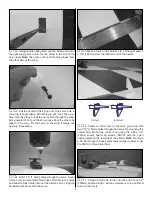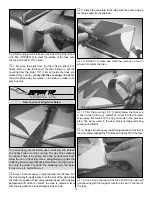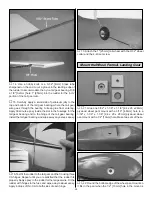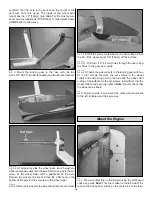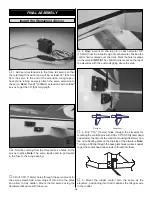
wear safety goggles, a particle mask and rubber gloves when
grinding, drilling and sanding fiberglass parts.Vacuum the parts
and work area thoroughly after working with fiberglass parts.
Remember: Take your time and follow the instructions to
end up with a well-built model that is straight and true.
If you have not flown this type of model before, we recommend
that you get the assistance of an experienced pilot in your R/C
club for your first flights. If you're not a member of a club, your
local hobby shop has information about clubs in your area
whose membership includes experienced pilots.
In addition to joining an R/C club, we strongly recommend you
join the AMA (Academy of Model Aeronautics). AMA
membership is required to fly at AMA sanctioned clubs. There
are over 2,500 AMA chartered clubs across the country.
Among other benefits, the AMA provides insurance to its
members who fly at sanctioned sites and events. Additionally,
training programs and instructors are available at AMA club
sites to help you get started the right way. Contact the AMA at
the address or toll-free phone number below:
Academy of Model Aeronautics
5151 East Memorial Drive
Muncie, IN 47302-9252
Tele. (800) 435-9262
Fax (765) 741-0057
Or via the Internet at:
http://www.modelaircraft.org
This is a partial list of items required to finish the U-CAN-DO 3D
.46 ARF that may require planning or decision-making before
starting to build. Order numbers are provided in parentheses.
4+ channel radio with 6 standard-sized servos as noted below.
Note that a 6+ channel, fully computerized radio system is
highly recommended for maximum flexibility and performance.
Ailerons:
• Two ball bearing servos (50+ in oz: FUTM0220)
• One 20+" y-harness (HCAM2751)
OR
• Two 6" extensions (HCAM2701) and one y-harness
(HCAM2500)
Rudder:
• One high torque servo (90+ in oz: FUTM0211)
• One 24" servo extension (HCAM2200)
Elevator:
• Two ball bearing servos (50+ in oz: FUTM0220)
• If using a computerized radio two 24" servo extensions
(HCAM2200)
• If not using a computerized radio with Ailevator programming,
then a servo reversing harness is required (FUTM4150)
Throttle:
• One servo, standard (FUTM0075)
.32 to .50 2-stroke, .52 to .70 4-stroke
Appropriate props, fuel, glow plugs, etc. for your engine.
In addition to the items listed in the “Decisions You Must
Make” section, following is the list of hardware and accessories
required to finish the U-CAN-DO 3D .46 ARF. Order numbers
are provided in parentheses.
Hardware and Accessories
ADDITIONAL ITEMS REQUIRED
For safe, exciting, and thoroughly
satisfying 3D performance...
RESIST the urge to overpower your U-Can-Do 3D .46
ARF in order to fly at speeds for which it was not designed
nor intended. Such choices put your model at high risk for
catastrophic failure and void any protections offered in its
warranty. Follow these carefully tested guidelines:
1. Do NOT use engine displacements greater than .50
2-stroke or .70 4-stroke.
2. Do NOT use propellers with pitch greater than 6 inches.
3. Do NOT fly full-throttle except during climbs of at least
20 degrees.
The U-Can-Do 3D .46 ARF’s fantastic low-speed
maneuverability is the result of light weight and very
large control surfaces – which are prone to flutter with
excessive airspeed.
So, use the engine and propeller sizes we recommend.
Make careful, routine pre- and post-flight inspections of
linkages and control surfaces. This model will then deliver
exactly the performance that attracts you to 3D flight.
If you prefer to take chances, however, expect to learn a
hard–and expensive–lesson.
CAUTION
Engine Recommendations
Radio Equipment
DECISIONS YOU MUST MAKE
We, as the kit manufacturer, provide you with a top quality
kit and instructions, but ultimately the quality and
flyability of your finished model depends on how you build
it; therefore, we cannot in any way guarantee the
performance of your completed model and no
representations are expressed or implied as to the
performance or safety of your completed model.
3









